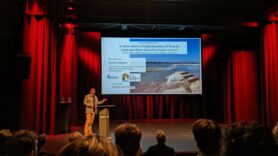News
To what extent is morphodynamics of Terai Arc Landscape rivers altered by human actions?
By Kshitiz Gautam, Mathieu E. Roebroeck, Thom Bogaard, Astrid Blom – April 2023
Faculty of Civil Engineering and Geosciences, Delft University of Technology, The Netherlands
Conference: 25th NCR Days- “Towards 2048, the next 25 years of river studies”
Date: 13 April 2023, Nijmegen, The Netherlands
PhD student Kshitiz Gautam presented preliminary results of his research project at the 25th edition of the NCR Days (Netherlands Centre for River Studies).
The objective of this research is to assess the influence of anthropogenic interventions (e.g., embankments, barrages, hydropower dams, and bridges) and climate change on the hydro-morphodynamics of rivers in the Terai Arc Landscape (TAL) in Nepal-India. The research is focused on the following two river systems in TAL: the Koshi and the Karnali River systems. It compares the historical flow paths to understand the fan dynamics, analyzes the hydrograph characteristics, and uses optical remote sensing images to study the planform change over time, and adopts morphological indices such as a Braiding Index to analyze the changes in planform of the selected river systems.
The Koshi fan is a much larger alluvial fan (≈10,000 km2) compared to the Karnali fan (≈800 km2 ). The Karnali mostly shows partitioning of flow between its two branches (Kauriala and Gerua), whereas the Koshi demonstrates lateral channel migration changing the entire course of flow. The flow path of the Koshi is mostly restricted between the embankments. The movement of its flow path within the embankments is influenced by the operation of the gates of the Koshi Barrage. In addition, construction of a new bridge in India, about 38 km downstream of the barrage, has significantly narrowed the Koshi at point. Similarly, the Karnali system has been less dynamic morphologically in the stretches where it has been embanked on both sides. The braiding index of these embanked reaches in Kauriala are lower than Gerua and has reduced over time. The water discharge in Gerua has significantly reduced after the river switched its major portion of flow to Kauriala in 2009. The extent of hydropower dams has increased more than 9 times in the Koshi river basin between 1995 and 2019, which likely is the cause of the declining peak flows of the Koshi River at Chatara. The Karnali River may be expected to be similar as several hydropower projects are foreseen.
To conclude, TAL rivers are naturally dynamic braided systems, but channelization measures have restricted these natural dynamics. Anthropogenic interventions have and will significantly influence the neo-dynamics of the TAL rivers.

To read the abstract please visit: https://cdn.bullit.digital/kbase/20230411204005/ncr-51-book_of_abstracts_ncrdays_2023_web.pdf#page=93

